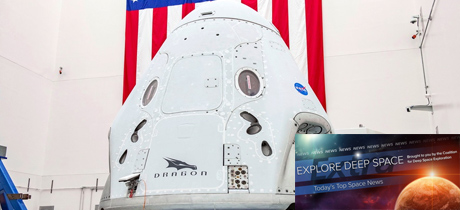In Today’s Deep Space Extra… NASA’s Space Launch System (SLS) program looks at ways to accelerate development of the Exploration Upper Stage (EUS). NASA safety panel views May 27 test flight of the Crew Dragon with two astronauts aboard as feasible. The Hubble Space Telescope turns 30 today. NASA fast tracks a ventilator for treatment of worst coronavirus symptoms.
Human Space Exploration
SLS program working on accelerating EUS development timeline
Coalition Members in the News – Aerojet Rocketdyne, Boeing, Dynetics
NASAspaceflight.com (4/23): The first envisioned upgrade to NASA’s Space Launch System (SLS) is the Block 1B version with a more powerful upper stage known as the Exploration Upper Stage, or EUS. Potentially, the EUS version could launch cargo, as much as 40 metric tons, to the Moon, while the initial version supported astronaut missions. As NASA led efforts to establish a sustained human presence at the Moon progress, the more capable 1B version could support lunar astronaut launches as well.
Safety panel concludes May launch of commercial crew test flight is feasible
Coalition Member in the News – Boeing
SpaceNews.com (4/23): During a virtual session on Thursday, NASA’s independent Aerospace Safety Advisory Panel declared plans by the agency and SpaceX to launch the company’s Crew Dragon to the ISS with two NASA astronauts on May 27 feasible, though some technical issues remain. The test flight, likely to include an extended stay at the space station for the astronauts Doug Hurley and Bob Behnken, is a significant milestone in NASA’s Commercial Crew Program certification process to begin the regularly scheduled launch of astronauts to the Space Station from the U.S. for the first time since NASA’s shuttle fleet was retired in 2011. The panel also urged continued vigilance by NASA and Boeing in preparations for two test flights of the company’s CST-100 Starliner. One is a redo of a truncated, uncrewed launch of the Starliner in December and the second a follow on crewed test flight to the Space Station, both required for NASA certification.
Safety panel urges longer-term ISS contingency planning
Coalition Member in the News – Boeing
Aviation Week (4/23): Encouraged by progress in the Commercial Crew program, NASA should expand planning for long-term staffing of the International Space Station (ISS) to provide options, NASA’s safety oversight panel said April 23. “The ISS program continues to take care of business, managing risk while juggling the still-difficult business of maintaining human presence in space with the new complication of the COVID-19 virus on the ground,” Aerospace Safety Advisory Panel (ASAP) member Paul Hill, a former NASA flight director, said during a teleconference meeting.
NASA asking people to stay at home to watch first SpaceX crewed launch in May
Florida Today (4/23): In response to the coronavirus pandemic, NASA is asking the public to watch the planned May 27 launch of NASA astronauts Doug Hurley and Bob Behnken over a TV or computer screen rather than in person. The Kennedy Space Center (KSC) is closed to normal work activity and the agency has long taken measures to protect its workers at other NASA facilities, including Mission Control, from the illness. The launch is considered historic. The nation has not launched humans into space since July 2011, when NASA’s shuttle fleet was retired.
Space Science
Hubble Space Telescope still going strong after 30 years in space
CBS News (4/23): Friday marks the 30th anniversary of the launch of the NASA led Hubble Space Telescope, which continues to operate well beyond its initial 15 year mission thanks to five NASA space shuttle servicing missions. “Obviously there will be other telescopes, but I don’t know if there’s going to be a telescope that takes us as far from sort of where we were to where we end up,” Adam Riess, who shared a Nobel Prize for his work with the telescope to assess the expansion rate of the universe, told CBS.
Scientists use Apollo data to create the best geologic Moon map ever
Space.com (4/23): A best yet, detailed map of the lunar surface, “the Unified Geologic Map of the Moon,” has been created by NASA, the U.S. Geological Survey and the Lunar Planetary Institute, all working together, and with a link: (https://www.usgs.gov/media/videos/unified-geologic-map-moon).
Other News
NASA develops COVID-19 prototype ventilator in 37 days
NASA/Jet Propulsion Laboratory (4/23): A high pressure ventilator developed by NASA’s Jet Propulsion Laboratory (JPL) and much needed in overcoming the coronavirus pandemic passed a critical test this week at the Icahn School of Medicine at Mount Sinai in New York. VITAL (Ventilator Intervention Technology Accessible Locally) was developed to treat the most severe COVID-19 symptoms. The agency has asked the FDA to fast track the approval process.
FCC punts controversial space debris rules for extra study
SpaceNews.com (4/23): FCC commissioners voted unanimously Thursday in favor of requiring satellite operators to quantify collision risk, and probability of successful spacecraft disposal via end of mission re-entry into the Earth’s atmosphere. Additional requirements, some of which have been questioned by the satellite industry, are to be assessed further. “If the U.S. wants to be a leader in the current space race, our regulatory processes cannot be more expensive and burdensome than those of other nations,” said FCC Commissioner Michael O’Rielly.

